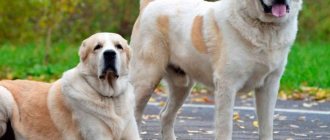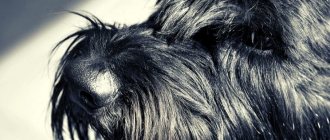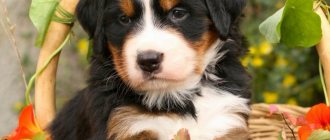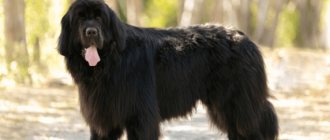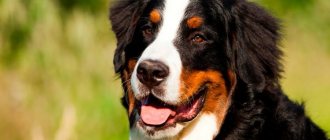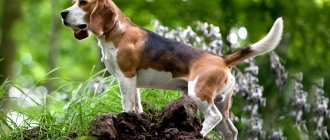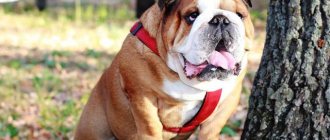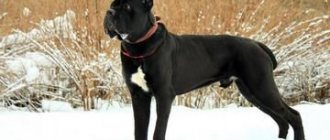Story
The Appenzeller Mountain Dog owes its appearance not to systematic breeding work, but rather to natural selection. It is assumed that his ancestors were ancient Roman war dogs who came to the Alps with Caesar's army. And, indeed, the first Sennenhunds that descended from them were distinguished by quite strong aggressiveness and fighting qualities.
However, the shepherds who inhabited the Swiss Alps from ancient times had no need for warrior dogs. They needed dogs to herd and protect herds, to help with the farm, well, in extreme cases, to protect livestock, the house and the owner, but not four-legged warriors.
During the assimilation of Roman Molossians with local dog breeds, Sennenhunds appeared. But for a long time they were a single breed, or, rather, a breed group, where animals of different weight, height and build were found.
Later, Mountain Dogs began to be bred according to their variety, thus giving rise to the four breeds of modern Swiss Cattle Dogs.
As for the Swiss Appenzeller Mountain Dog itself, it was bred in Appenzell, a historical region located in the northeast of Switzerland. Medium-sized, short-haired dogs with an elegant tricolor black-white-red or brown-white-red color were used there as assistants to local shepherds and guards. But until the beginning of the 20th century, no one viewed them as anything other than working dogs, not suitable for exhibitions and breeding. And they weren’t considered a breed then.
Recognition for the Appenzellers came later, when professional dog handlers became interested in them. In 1906, the first breed club of Appenzeller Mountain Dogs was created and a stud book was established. And in 1916, the first standard of this breed appeared.
THIS IS INTERESTING! Despite the fact that breeding work had already been carried out ten years before the development of the first standard, until 1913 Appenzeller and Entlebucher Mountain Dogs were considered one breed.
International recognition for the Appenzellers came late. Until 1989, the FCI did not recognize them as a breed. But after that, Appenzellers surprisingly quickly became one of the most popular dog breeds in the world. Nowadays, of course, they are used less and less in accordance with their original purpose and have become simply companion dogs with whom it is easy and friendly to communicate, and also favorites of numerous exhibitions and sporting competitions.
History of the origin of the breed
The Appenzeller Mountain Dog is one of four species of Swiss Cattle Dogs. Until relatively recently, the mountainous regions of the country had no communication with each other, and each part had its own types of dogs, which peasants and farmers used to protect their herds and territories.
The homeland of Appenzeller is the canton of the same name in northeastern Switzerland. This is a breed with a long history. According to some information, such dogs have faithfully served people since the end of the 1st century BC. and are descendants of the ancient Alpine dog. It is possible that the blood of mastiffs and Rottweilers flows in them.
In the middle of the 19th century, in the book “Animal Life in the Alps,” the first mention and description of the loud-voiced, medium-sized Swiss Mountain Dog with a distinctive color appeared.
At the end of the 19th century, these dogs interested the Swiss dog breeder Franz Schertenleib, and he began breeding them. In 1898, thanks to Max Siver, a great admirer of these dogs, they were identified as an independent breed.
He also made an accurate description of the breed, which was accepted as the first standard. And in 1906, the first club of Appenzeller lovers was founded and a stud book appeared. The Appenzeller Mountain Dog received its current official name in 1908.
The breed was recognized by international canine organizations only in 1989. The Appenzeller Mountain Dog received the greatest reverence and distribution in its homeland in Switzerland, where it is considered a national treasure. In other countries it is less known and popular. This is a fairly small breed that is on the verge of extinction.
Description of the breed
Description of the breed with explanatory photos:
Color
Like all other Sennenhunds, the Appenzeller is distinguished by a bright, elegant tricolor color, in which on the main background, or, as dog breeders say, the “shirt,” there are spots of other, contrasting colors: reddish-red and white. Moreover, these spots are not scattered in disarray, but are located in strict accordance with the requirements prescribed in the standard.
- Red-red: above the eyebrows, muzzle, on the inside of the ears. On the chest, on the paws (reaching approximately to the hocks), on the back of the tail.
- White: Forms a "T" shaped marking on the dog's forehead and muzzle. On the chin and on the neck, on the chest it forms a mark in the form of a cross and seems to be bordered along the edges with red spots. Also, the Appenzeller must have white paws and (preferably) the tip of the tail.
THIS IS INTERESTING! The Appenzeller is the only Mountain Dog whose standard allows not only a black base color, but also a brown color. In this case, the color of the undercoat can be black, gray or fawn (in dogs with a brown “shirt”).
This color is called “Havana”
Appearance
- The head is wedge-shaped, proportional to the body, of sufficient width, but not heavy and, moreover, not coarse.
- The wide, flat forehead is divided by a clearly visible groove. The transition to the muzzle is not abrupt, but rather smooth.
- The back of the head is not convex, but rather rounded. In this case, the skull and muzzle should be in a ratio of approximately 10:9 in length.
- The bridge of the nose is flat, the lobe protrudes slightly beyond the jaw. Cheekbones and cheeks are well developed, lips are tight-fitting and not drooping.
- The teeth are strong and straight. A scissor bite is desirable, although a pincer bite is acceptable. The absence of 1-2 permolars or molars that complete the dentition is also acceptable.
- The pigmentation of the nose, edging of the lips and eyelids is black or brown depending on the color.
- The eyes are round in shape, the inner corner of the eyelid is lowered towards the nose.
- The ears are triangular with rounded tips, relatively large in size. Their stance is wide and quite high. At rest they lie close to the sides of the head, and when excited they turn forward.
- The body is rectangular in format, but not stretched, but compact.
- The neck is quite powerful and strong, medium in length. The transition from it to the withers is not abrupt. The back is of moderate length, wide, with well-developed muscles.
- The chest is oval in shape, quite deep and moderately convex. The abdomen is moderately tucked.
- The limbs are strong, strong and muscular, their set is relatively wide. The hind legs in the stance are pulled back slightly, the elbow and hock joints are parallel to the body.
- The paws are round in shape, strong, with tightly clenched, curved toes. The pads are covered with rough and thick skin.
- The tail is quite thick and medium in length. If the dog is calm, the tail is directed downwards, but in a state of excitement it is thrown over the back, so that its tip either lies on the dog’s back, or extends over it and hangs to the side.
- The Appenzeller's coat is of medium length, very thick and even, with a well-developed undercoat of the same or lighter shade than the main color.
IMPORTANT! The Appenzeller Mountain Dog should look strong and muscular, but not rough and certainly not raw. However, excessive dryness of build is also a serious drawback.
Dimensions
- Male height: 50-58 cm.
- Bitch height: 48-56 cm.
- The weight of dogs of this breed ranges from 22 to 32 kg.
The standard does not regulate the body length of dogs of this breed, but in any case it should be proportional to height.
Puppy weight and height by month:
- 1 month : 3 – 4 kg.
- 2 months : 7 - 8 kg.
- 3 months : 9.5 - 11 kg.
- 4 months: 12.5 - 14.5 kg.
- 5 months: 16-19 kg.
- 6 months 21-23 kg.
- 7 months 22-24 kg.
- 8 months 22 - 25 kg.
- 9 months 22 - 27 kg.
- 10 months 22 - 29 kg.
IMPORTANT! After a puppy reaches the age of six months, its weight increases slightly, so the weight gain per month for an individual dog can be less than half a kilogram. Most Appenzellers, who will weigh 22-26 kilograms as adults, stop gaining weight altogether at 6 months or gain very little.
Howl and bark
Bred for herding livestock and for driving herds with a voice, the Appenzeller is not averse to barking and howling. But it depends only on the owner and how much time and effort he devotes to training his pet whether the dog will bark solely on business, say, to drive away a thief, or whether he will bark endlessly for the most insignificant reason, reacting to the slightest noise.
It is very important from an early age to teach the puppy to stay at home alone and at the same time behave silently, only in this case, after the Appenzeller grows up, he will begin to bark only when it is required of him.
Appearance and size - breed standard
Unlike the large Bernese Mountain Dog, the Appenzeller is a medium-sized dog with an almost square format. Breed standard in size: weight from 22 to 32 kg, height at the withers from 50 to 56 cm. This is a tightly built dog with well-developed muscles, a wedge-shaped head with drooping ears and a perky tail that curls into a ring, like a Spitz. Its average size is allowed. It is appropriate to compare the Appenzeller and Entlebucher Mountain Dog breeds: the smaller Entlenbucher Mountain Dog has a shortened tail, but if we ignore this exterior nuance, then these two dogs are very similar. Like all Sennenhunds, they have a tricolor color. A real Appenzeller twists his tail so that the hole in this donut is not visible. Incomplete twisting, under-twisting (tail with a sickle and in the form of a loop) is a breed defect.
Standards in detail:
- eyes – almond-shaped, only dark;
- nose – black;
- ears are wide and fit tightly to the cheeks;
- bite – scissor bite, a small Pinscher overbite is allowed.
The most stringent requirements are for color: the coat must be black with bright brownish and white splashes. Moreover, the colors should be placed as strictly as the coloring of a geographical atlas: the tips of the paws (socks) and tail should be white, as well as the stripe running from the white spot around the nose to the skull, and from the chin to the chest. Reddish fur can only be located on the border of black and white.
Asymmetrical color, spots of any color on white fur are defective. But at the same time, there are very rare specimens with a base brown rather than black color.
The smooth-haired Appenzeller tolerates cold well, it has a very dense coat: under the thick awn it has a magnificent down. Like German Shepherds, Appenzellers can exhibit a recessive gene for long hair. This is a reason for culling and a ban on mating. The responsible nursery must do a genetic test of the parents before mating.
Where is the best place to buy a puppy: nurseries
If you decide to take an Appenzeller, then it is better to buy a puppy either in a nursery or from professional breeders. This breed is still new for Russia, and therefore the list of well-known domestic nurseries dealing with this breed for 2021 is very small:
- From "Noble House"
- FIDELITY HEARD
- EBERRON
- SHEKSBURG
- Vingenium
Contacts where you can contact the breeders can be found on the websites of any of the above listed nurseries.
Price: how much does it cost
Due to the fact that there are still few dogs of this breed in Russia, and most of the producers are brought from foreign nurseries, the cost of an Appenzeller puppy cannot be small. So, a pet-class baby can be purchased for twenty thousand rubles and more, but for a promising show-class puppy you will have to pay sixty thousand and more.
Owner reviews
Believe me, you won’t find negative reviews from the owners of these wonderful dogs all over the Internet:
Alexei:
“Two years ago we became the happy owners of a miracle named Ralph of the Appenzeller Mountain Dog breed, and during all this time we have never regretted that we bought him, and not a Bernese, as we first wanted. Our dog is incredibly smart: he seems to know commands from birth and happily carries them out. He especially loves the “Voice” team, however, this is how they are supposed to be by their breed - shepherd dogs, bark when corralling cows and sheep. And we have an excellent security guard, I must say. And it's a pleasure to walk with him. We also took him on bicycle trips with us, the dog can handle all road difficulties very well. Although no, transfers is not the right word. He just enjoys it all...”
Catherine:
“Several years ago we didn’t even know these dogs existed. And then suddenly they saw him in a book on dog breeding, and that’s it - it was love at first sight. But we learned about how wonderful animals they are, these Appenzellers, only when we got our Bertha. She's just crazy smart. From a half-glance she understands what we want from her, I never remember a case where Bertha refused to carry out some command. You can safely leave her with the children: she will look after them and watch over them, so that no stranger will offend...”
Julia:
“I always dreamed of a dog, but when my husband gave me something strange, black, white and red for my birthday, and even said that it was some kind of Appenzeller that I had never heard of in my life, I was shocked. But Sam, as we named the puppy, literally charmed us not only with his unusual appearance, but also with his intelligence. It’s a pleasure to train him; he remembers all the commands right away. You wouldn't say that Sam is malicious towards strangers, but he is an excellent guard. True, sometimes a mischievous person will steal a slipper or a glove and run with it throughout the apartment, as if teasingly: “Come on, take it away!”...
History of the breed
There is no reliable information about the origin of the breed. There are four types of Mountain Dogs: the Appenzeller, the Bernese Mountain Dog, the Greater Swiss Mountain Dog, and the Entlebucher Mountain Dog.
One thing is clear, this is an old breed about which there are several theories. One of them says that Appenzellers, like other Sennenhunds, descend from an ancient Alpine dog. Archaeological research has shown that Spitz-shaped dogs have lived in the Alps for thousands of years.
Genetic studies have confirmed that the ancestors of the breed were massive dogs, light in color, intended to guard livestock. Most likely, all Swiss Cattle Dogs are descended from the same ancestor, although there is no hard evidence for this.
Until recently, communication between the two valleys in Switzerland was very difficult. As a result, dog populations, even in nearby cantons, differed significantly from each other.
There were probably dozens of different Mountain Dogs that served farmers for hundreds of years. Their service lasted longer than that of other similar breeds, since modern technology came to the Alps later than to other countries of Western Europe.
But, as a result, progress reached the most distant villages and in the 19th century the popularity of the breed decreased significantly. Many of them simply disappeared, leaving only four varieties of herding dogs.
The Appenzeller Mountain Dog was lucky because her homeland, the city of Appenzell, was located far from large cities such as Bern.
In addition, she now has a defender - Max Siber. Sieber was the main promoter of the breed and was seriously involved in its conservation. In 1895 he requested the help of the Swiss Kennel Club to preserve the Appenzellers.
The Canton of St. Gallen, the administrative district that includes the city of Appenzell, also provided assistance by collecting voluntary donations for the restoration of the breed. The Swiss Kennel Club created a special commission to breed the remaining dogs.
During the 20th century, Appenzeller Sennenhunds, although they found their way to other European countries and even to the United States, remained a rare breed. In 1993, the United Kennel Club (UKC) registered the breed and classified it as a service breed.
A small number of lovers of these dogs living in the USA and Canada organized the Appenzeller Mountain Dog Club of America (AMDCA).
The AMDCA's goal was to have the breed recognized by the largest organization, the American Kennel Club, since the three remaining Swiss Cattle Dog breeds had already been recognized.
The Appenzeller Mountain Dog is similar to other Swiss Cattle Dogs, but it is the most unique of them all. Males at the withers reach 50-58 cm, females 45-53 cm. Weight ranges from 23-27 kg. They are very powerful and muscular, but do not look squat or stocky. Overall, Appenzellers are the most athletic and elegant of all Mountain Dogs.
The head and muzzle are proportional to the body, wedge-shaped, the skull is flat and wide. The muzzle flows smoothly from the skull, the stop is smoothed. The eyes are almond-shaped and small.
Dark eye color is preferred, but dogs can also have light brown eyes. The ears are small, triangular in shape, with rounded tips, hanging down to the cheeks, but can rise when the dog is attentive.
The coat is double coated, with a soft, dense undercoat and a short, smooth, thick outer coat. Color and spots are very important to the breed. Appenzeller Mountain Dogs should always be tri-colored.
The base color can be black or Havana brown, but black is much more common. White and red spots are scattered across it. Red spots should be above the eyes, on the cheeks, on the chest, on the paws and under the tail.
These dogs have the most working character of all the other Sennenhunds and in some ways it resembles the character of the Rottweiler. They are very devoted to their family, almost without memory. They want nothing more than to be close and the lack of attention makes them sad. Although they are friends with all family members, most Appenzeller Mountain Dogs are loyal to one person.
If a dog is raised by one person, then such devotion will be 100%. When properly socialized, most are good with children, although puppies can be too active and noisy for small children.
It happens that they are aggressive towards other dogs and small animals, although in general this is not typical for the breed.
Socialization and training are very important for dogs to develop correct behavior towards other creatures, but still, when meeting new pets, you need to be very careful.
For centuries, the task of these dogs was protection. They are suspicious of strangers, some very suspicious. Socialization is important, otherwise they will view everyone as a potential threat.
But, if socialized correctly, most will be polite to strangers, but very rarely friendly. They are not only excellent guards, but also watchmen. The Appenzeller Mountain Dog will never allow a stranger to pass unnoticed near his territory.
If necessary, he will boldly and confidently defend her, and at the same time show unexpected strength and dexterity.
These dogs are very smart and very efficient. They learn very quickly and are excellent at training. But, although they are not a dominant breed, they will nevertheless happily sit on the neck if the owner allows it. The owner needs to be firm but kind and take a leadership position.
Naturally, these dogs need physical activity, because they were born in the free Alps. An hour of walking a day is required, preferably even more. Dogs that do not have enough activity will develop behavioral problems.
This could be hyperactivity, destructive behavior, constant barking, or aggression. Regular work helps a lot, the kind that loads the body as well as the head. Agility, canicross and other sporting activities work well.
But they feel truly comfortable in a private house, preferably in a village. A large yard, your own territory and strangers from whom you need to protect - the ideal combination. They are much less suitable for keeping in an apartment; they need more freedom and space.
Relatively uncomplicated. Although they shed profusely during the seasons, this only requires additional brushing. Otherwise, care is similar to other breeds - you need to trim the nails, check the cleanliness of the ears and brush the teeth.
Characteristics: pros and cons
pros
- + Energetic, active and cheerful.
- + Incredibly smart and quick-witted.
- + Friendly and not too aggressive.
- + These dogs have a well-developed protective instinct; they make excellent watchdogs.
- + Gets along well with other pets, including cats.
- + They are not inclined to choose only one leader in the family; they recognize all family members of their owner equally.
- + Well suited for families with children, but it is advisable that the children are not too small and understand that a dog is not a toy.
- + They are not inclined to bite and are generally not very aggressive.
Minuses
- - They can be headstrong and stubborn.
- — If you don’t pay attention to upbringing, they can become empty-headed.
- — They need great physical activity, which is not always possible to provide in urban conditions.
- — These dogs definitely need to be “puzzled” with some kind of task, otherwise the Appenzeller may acquire bad habits, and his character in this case acquires destructive traits.
- - They tolerate loneliness relatively poorly and need constant contact with the owner, for this reason Appenzellers cannot be kept on a chain.
Character
These dogs have the most working character of all the other Sennenhunds and in some ways it resembles the character of the Rottweiler. They are very devoted to their family, almost without memory. They want nothing more than to be close and the lack of attention makes them sad. Although they are friends with all family members, most Appenzeller Mountain Dogs are loyal to one person.
If a dog is raised by one person, then such devotion will be 100%. When properly socialized, most are good with children, although puppies can be too active and noisy for small children.
It happens that they are aggressive towards other dogs and small animals, although in general this is not typical for the breed.
Socialization and training are very important for dogs to develop correct behavior towards other creatures, but still, when meeting new pets, you need to be very careful.
For centuries, the task of these dogs was protection. They are suspicious of strangers, some very suspicious. Socialization is important, otherwise they will view everyone as a potential threat.
But, if socialized correctly, most will be polite to strangers, but very rarely friendly. They are not only excellent guards, but also watchmen. The Appenzeller Mountain Dog will never allow a stranger to pass unnoticed near his territory.
If necessary, he will boldly and confidently defend her, and at the same time show unexpected strength and dexterity.
These dogs are very smart and very efficient. They learn very quickly and are excellent at training. But, although they are not a dominant breed, they will nevertheless happily sit on the neck if the owner allows it. The owner needs to be firm but kind and take a leadership position.
Naturally, these dogs need physical activity, because they were born in the free Alps. An hour of walking a day is required, preferably even more. Dogs that do not have enough activity will develop behavioral problems.
This could be hyperactivity, destructive behavior, constant barking, or aggression. Regular work helps a lot, the kind that loads the body as well as the head. Agility, canicross and other sporting activities work well.
But they feel truly comfortable in a private house, preferably in a village. A large yard, your own territory and strangers from whom you need to protect - the ideal combination. They are much less suitable for keeping in an apartment; they need more freedom and space.
Conditions of detention
Where is it better to live: in an apartment or a house?
The Appenzeller was bred in the mountains of Switzerland as a working farm dog. Undoubtedly, this dog will feel best in a country house, but at the same time, he can easily live in a city apartment. True, provided that he is provided with sufficient physical activity.
How should you walk?
- In rural areas, the Appenzeller must be given the opportunity not only to walk on a leash, but also to run in the forest or meadow, away from roads and cars.
- In the city, a dog of this breed must be walked at least twice a day, and the walks should be long.
- The Appenzeller can only be allowed to run without a leash in fenced special areas.
- Active games outside are useful, as well as swimming in the warm season.
- And, finally, it would be nice to take your pet out of town at least once a week, into nature, where he could run around to his heart’s content, away from people, cars and stray dogs.
Choosing a puppy
It is best to choose dogs of this breed in official kennels or from good breeders. Due to the fact that there are very few representatives of this breed, it is difficult to breed, so when choosing, you need to carefully check everything. You need to make sure that the puppy is purebred, especially if you plan to participate with it in exhibitions and competitions.
The ideal option is to meet the puppy's parents. You need to take a good look at the place where the dogs are kept and see how the puppies behave - how active and curious they are. A good puppy should be the most inquisitive and fearless.
Features of care
It is best to keep an Appenzeller Mountain Dog in a private house with an existing local area enclosed by a fence. Then the dog will have the opportunity to run around the area. Keeping dogs of this breed in an enclosure or on a leash is not allowed; they must live in the house.
An Appenzeller can also live comfortably in an apartment, but then the owner must provide him with regular long walks combined with physical activity.
Walks
You need to take your dog for walks 2-3 times a day. On weekends, it is best to take your pet to the forest or field so that he can run around there and throw out all the energy that has accumulated over the week.
An ordinary walk on a leash is not suitable for such a dog. They should run, play active games and exercise.
REFERENCE! You need to let your dog splash out his energy on walks, otherwise he will start acting up in the house.
Nutrition
Representatives of the described breed are prone to obesity, as they cannot refuse an extra portion of food. Therefore, it is the responsibility of the owner, who must choose the correct portion size for his pet and limit the excess. If overfed, the dog will develop obesity and along with it other diseases. The diet should consist of 50 percent meat and 50 percent porridge with vegetables. It is also necessary to add a vitamin-mineral complex to the diet.
In addition to natural feeding, you can also feed your dog commercial dry food. In this case, information about serving sizes is indicated on the packaging. The main thing is to choose premium food.
Wool. Caring for the Appenzeller's coat involves brushing it every other day. These dogs have a lot of undercoat, so brushing is necessary.
Eyes, ears, teeth, claws. It is mandatory to examine the animal's eyes, ears, claws and teeth once a week. Ears and teeth should be cleaned approximately once a month. This dog's nails usually grind down on their own, but if this does not happen, they need to be trimmed as needed.
Necessary care
Feeding
The Appenzeller Mountain Dog is not one of the problem breeds that require special diets. You can feed him either dry factory food of no lower than premium class (show dogs are better given food of super premium class and higher), or natural products.
If the choice is made in favor of natural food , then you need to take into account that meat and meat products should account for no less than half of the daily diet, and the rest, in addition to cereals, should also include fermented milk, vegetables and fruits. Also, when feeding naturally, it is necessary to give the dog vitamin and mineral complexes.
ATTENTION! If a dog suffers from urolithiasis, then it is best to feed it with special dietary food, rather than create a feeding diet yourself.
It should be remembered that Appenzellers are big eaters, and if you do not give them enough exercise, they gain excess weight very quickly . Therefore, you need to give your dog only its food allowance, and not supplement it with tasty treats from your table.
Important articles on nutrition:
- Compatibility test: can a dog have milk and fermented milk products?
- Feeding for all occasions: what to feed your dog in 20 specific cases
- Tips and recipes from experienced dog handlers: porridge for dogs
Washing and grooming
The Appenzeller is a short-haired dog and caring for him is not particularly difficult:
- combed at least 1-2 times a week; during the molting period, this procedure should be carried out daily.
- Eyes and ears are cleaned as needed, and nails are trimmed as they grow.
- It is also necessary to monitor the condition of your pet's teeth and brush them as needed.
- But it is not recommended to bathe the Appenzeller often. Ideally, wash it twice a year, and it would be better during shedding, using a dog wash. If your dog gets dirty and it’s too early to bathe him, you can either wash off the dirt with plain water or use dry shampoo .
Care and maintenance
1. Grooming. The Appenzeller's coat is short, healthy and shiny in normal condition, and requires regular grooming. First of all, this is combing, as well as maintaining the white spots in a clean condition to preserve the decorative appearance of the dog.
Combing is carried out especially carefully during the molting period, when the dog naturally gets rid of its old fur. Combing allows you to evenly distribute the lubricant throughout the animal’s body, causes a rush of blood to the hair follicles due to massage during combing, and helps the coat have a healthy, shiny appearance.
White marks are usually wiped off with wet wipes if the dog gets dirty while out for a walk. Frequent washing is possible, but is not strictly necessary.
2. Teeth. Teeth are cleaned with a special paste and brush. They purchase special “cleaners” that, when chewed by a dog, remove plaque from the teeth.
3. Ears. The ears are wiped with special lotions and carefully protected from water during bathing.
In general, caring for a dog differs little from keeping other guard and herding breeds. However, special attention should be paid to the place where the dog will live. Appenzellers should not be chained or locked in an apartment all day.
This is a dog that is genetically adapted for life in nature and, at a minimum, it needs its own fairly spacious outdoor enclosure with the possibility of access to an open area. You can keep such an “energizer” in an apartment only if it is possible to provide her with a lot of time for walking together on the street.
Training and education
- It is necessary from the very beginning to make the appenzeller understand who is in charge in the house, and that any member of the owner’s family is higher in rank than the dog.
- When training a dog of this breed, you need to remember that until the animal runs around to its heart’s content, it will not be able to fully engage: it will be constantly distracted, which may make it worse for them to remember commands.
- It is very important to do this without harsh coercion, no matter how ridiculous it may sound, but it is better to come to an agreement with the dog peacefully than by tugging on the leash and screaming, not to mention beating.
IMPORTANT! The owner of an Appenzeller should always be able to insist on his own, this will help the dog better understand that he must obey his owner unquestioningly. You also need to decide from the very beginning what the animal can do and what it cannot do, and in the future you need to be consistent and not allow the dog to do things that five minutes ago were strictly prohibited.
Differences from Entlebucher
The main difference between these breeds is size. The Entlebucher Mountain Dog is noticeably smaller than the Appenzeller , and therefore may be better suited for a city apartment than its larger “relative.” For a private house and, especially, a farm, a larger appenzeller is much better suited.
Appenzeller/Bernski/Gross/Entlebucher
Swiss Mountain Dog or Labrador: which one to choose?
This question is quite difficult to answer, if only because these breeds were bred for different purposes, which affected their character and appearance.
The Appenzeller was originally a herding dog, but which, nevertheless, was also supposed to guard the house.
Labrador is a hunting breed, designed to track and then present killed game to the hunter. Nowadays, Labradors have also become companion dogs, but they have not lost their hunting instincts, but have not acquired protective qualities.
Therefore, answering the question of who to choose - an Appenzeller or a Labrador, you can answer this way: if you need a guard dog, then it is better to choose an Appenzeller Mountain Dog, but if you are a hunter, then a Labrador would be preferable for you. In general, the choice of one breed or another is a matter of personal taste of the potential owner.
Breed standard
The Appenzeller Mountain Dog is a well-built, medium-sized animal. The dog's height at the withers is 50-56 centimeters, and its weight is 22-32 kilograms. The animal looks very strong and muscular. The dog's whole body is filled with strength and energy. It is covered with thick fur, consisting of two layers: a warm, thick undercoat and a shiny coat. At home, the dog has to spend most of its time in the harsh alpine winter, so its coat is adapted to survive in such difficult conditions.
Appenzellers live 10-14 years. Animals are characterized by a tricolor color, but this does not mean that it is arbitrary. According to the standard, the dog must have a black main color (but sometimes brown specimens are also found). The presence of white color is allowed in the following form:
- The white stripe may extend from the nose to the skull in a continuous stripe, covering part or all of the muzzle.
- There are white “socks” on the animal’s paws.
- There is also a large white patch from the chin to the neck.
- White tip of the tail.
White spots on the back of the head and a white collar are allowed, but their presence is undesirable. In addition, colored patches are not allowed on light areas of the coat.
Interesting Facts
- The Appenzeller Mountain Dog was bred in Appenzell, a historical region located in northeastern Switzerland, also famous for a special type of cheese that is produced only there.
- These dogs feel the emotions and mood of their owners so sensitively that sometimes it may seem as if they read people's thoughts.
- Currently, Appenzeller Mountain Dogs are used as rescue dogs: they help find people after avalanches or other natural disasters, in this they are greatly helped by the inherent intelligence, independence and loud barking of dogs of this breed, which in other circumstances is considered a disadvantage by many.
Features of the Appenzeller Sennenhund breed, applicability and care
The Appenzeller was primarily used as a pure herding dog. Later they began to use him also as a watchdog, although now this “profession” is rarely found among Appenzellers. The Appenzeller is also used as a service dog, for example, rescue dogs, bloodhounds, orderlies - any type of activity that requires ingenuity, good reaction, and attention is suitable for them. Today, the Appenzeller is increasingly used as a companion dog.
The Appenzeller is characterized by a friendly character and a cheerful, easy-going disposition. These are very calm, confident dogs, with an active, lively character. These Swiss beauties become very attached to the family in which they live and are affectionate with all family members. These dogs are friendly to children and will play with them with pleasure, but they are unlikely to obey the child unconditionally, as they will perceive him rather as their ward. It is important to take into account that, like almost any shepherd dog, the Appenzeller is prone to dominance, which manifests itself mainly in the desire to protect and look after his “herd.” The Appenzeller will get along quite comfortably with other pets, although it will tend to “herd” them, especially if the other animals are smaller in size.
In addition to herding, the Appenzeller has developed protective qualities and watchdog instincts. He will inform you about arriving guests with a loud, long bark. Also, these dogs are quite wary of people whom they see for the first time, and only after realizing that the person is not a threat to his family will the Appenzeller show goodwill.
The Appenzeller is devoted to his owner, strives to guess his every gesture, and make friends at all costs. Training these dogs will not be difficult - they are very trainable and smart, and easily remember commands. It is easy to learn all sorts of tricks and tricks with the Appenzeller, which is why they are often winners at exhibitions and competitions. With all the Appenzeller’s desire to please his owner, one must remember that these are self-sufficient dogs prone to dominance. From this follows the conclusions that, firstly, you need to firmly but delicately convey to the dog who is the boss of the house; and secondly, in the process of raising a Sennenhund, you cannot humiliate or beat the dog. You also cannot keep the Appenzeller on a chain, even if you keep the dog in a suburban area, it is better to build it a spacious enclosure. Appenzellers excel in dog sports, such as agility, freestyle, and weight-pulling.
Appenzellers value physical activity and mobility. During walks, which must be regular, try to let the dog off the leash, play with it, throw it a ball or stick so that it can run. At least once a week, this game should last at least an hour - this will keep the dog’s muscles in the necessary tone. If you keep a dog in a city apartment, try to at least sometimes take it out of town so that it can run and frolic to its heart's content. If you want to get away from the computer, move more, play sports or lose weight, the Appenzeller will be an excellent companion in this matter.
In general, the Appenzeller Mountain Dog is easy to care for. However, there are standards of care that are typical for almost all dogs. For example, periodically brushing a dog's shiny coat is an important step for removing dead hair, maintaining a beautiful appearance of the coat, and keeping the house clean. Twice a year, the Appenzeller goes through active shedding phases (when a lot of hair falls out), which requires frequent combing.
The Appenzeller Mountain Dog is a healthy breed for the most part. But since it is increasingly separated from its usual conditions and habitat, dogs can still get sick. Therefore, they need (and are very important) timely regular vaccinations. Constant physical activity and a balanced diet are also important for a dog’s health. There are no special complaints about the diet; adhere to the same rules for selecting a diet as for other large and medium-sized dogs. If your dog eats from your table, do not forget about additional mineral and vitamin complexes. The type of coat, by the way, also very much depends on a balanced diet.
At least once a week it is necessary to examine the dog's teeth, eyes and ears, and clean them if necessary. If a dog’s nails do not grind down on their own so that they do not interfere with the dog’s normal functioning, they need to be trimmed.
Photo
Video
The nuances of raising a dog of this breed:
The Appenzeller Mountain Dog is medium in size among the Swiss herding breeds and, like its larger “relatives,” is distinguished by its courage, intelligence and quick wit. It has naturally good protective qualities. This dog is sweet and kind around the family, but distrustful of strangers, although not aggressive towards them.
He can live both in a house and in a city apartment, since he does not need much space. The Appenzeller Mountain Dog, if properly raised and trained, will certainly become a devoted friend and a wonderful guard dog. And you will never regret choosing it.
Share stories about your Appenzellers, experiences and tips on keeping or breeding them, as well as photos of your pets of this wonderful breed in the comments to this article.
Description of the Appenzeller Mountain Dog
Representatives of this breed are popular all over the world. They can be kept in private houses or apartments. They resemble Rottweilers in character
It is important for these animals that the owner is always nearby. For correct and adequate behavior, you need to socialize and raise your pet in a timely manner.
The description of the Appenzeller Mountain Dog breed indicates a high level of intelligence and performance of the animal.
Training should take place in the form of active play and not depress the dog. These dogs are used in rescue operations related to searching for people in the mountains or after natural disasters. Many people are interested in how much an Appenzeller Mountain Dog costs. Dogs can be purchased from kennels, where the average price is $700.
History of the Appenzeller Mountain Dog breed
The breed owes its appearance not to systematic selection, but to natural selection. There is a version that the Romans brought their powerful guard dogs into the country, which bred with herding dogs. As a result, a new breed appeared that was used to help herd herd animals. Initially, this was problematic because the dogs were very angry and attacked animals more than they protected them.
A long period of assimilation was required. The dog got its name from the canton of Appenzell, which is located in the east of the country. At first it was one type of animal, which only after a while was divided into several separate breeds based on external characteristics. The first club was founded in 1906, while the official recognition of the Sennenhund dog occurred in 1989, despite the fact that the historical roots of the origin of the breed go far into the past.
Appenzeller Mountain Dog – standard
The Swiss Appenzeller Mountain Dog breed is endowed with external standards:
- grow at the withers up to 50-56 cm;
- average weight is 22-32 kg;
- the head is wedge-shaped with smooth transitions to the muzzle;
- triangle ears are wide and have rounded tips;
- eyes are almond-shaped, dark in color;
- the nose is straight with a large brown tint;
- scissor bite;
- the body is rectangular and compact;
- the chest is oval in shape, the stomach is retracted;
- limbs are strong and wide apart;
- rounded paws with curved toes;
- thick, medium-length tail;
- The medium-length coat is thick and even with a thick undercoat;
- color black or brown with bright red-red and white splashes.
